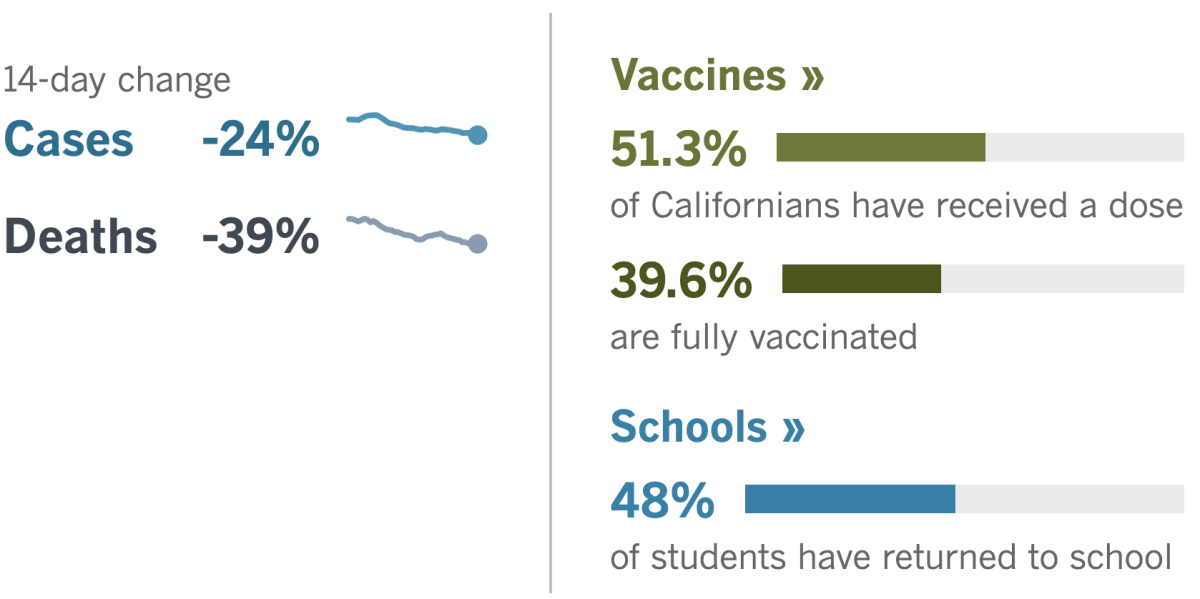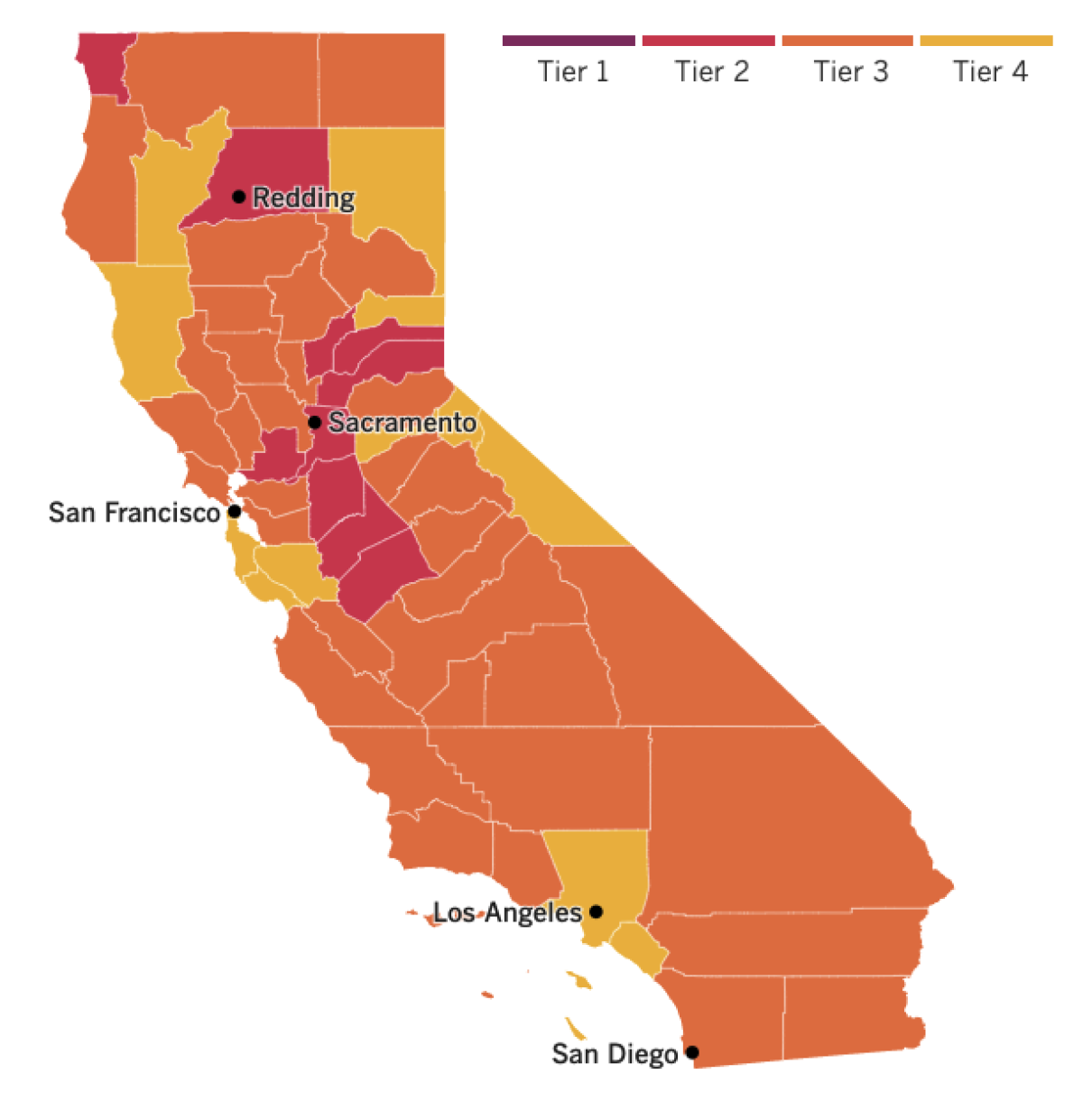Coronavirus Today: Don’t let the Games begin
- Share via
Good evening. I’m Kiera Feldman, and it’s Tuesday, May 18. Here’s what’s happening with the coronavirus in California and beyond.
How do you say “No Olympics” in Japanese?
The Summer Games are slated to begin on July 23 in Tokyo, and the host country is not having it. Polls show that 60%-70% of the Japanese public wants the event canceled. The world should listen and call off the Games, sports columnist Dylan Hernández writes.
In normal times, Japan embraces Olympics-mania. But not this year. Less than 3% of the population has been vaccinated against COVID-19, and the country remains under extended emergency measures because of the spread of new and more contagious coronavirus variants.
Against that backdrop, the Tokyo Olympics organizing committee has made some requests that Hernández says show why canceling ought to be a no-brainer. For instance, the Japanese Nursing Assn. was asked to dispatch 500 nurses for the Games, while 30 hospitals were asked to admit infected athletes ahead of other patients.
Hernández says there’s simply no justification for diverting precious medical resources from an already strained healthcare system. Japan has very few intensive care beds — about five per 100,000 people in 2019, according to the Organization for Economic Co-operation and Development. By comparison, the United States has nearly 26. And even so, the U.S. faced crushing shortages of hospital beds pretty much everywhere the virus surged.
Japan has already banned foreign fans from attending the Olympics. But even without spectators flying in, the country would have to deal with the arrival of tens of thousands of athletes, support staff and journalists.
The voices of opposition in Japan are many.
Prominent business leaders have spoken out against the Olympics. Hiroshi Mikitani, chief executive of online retailer Rakuten, called the Games a “suicide mission.” SoftBank chief executive Masayoshi Son told CNBC he would be “afraid” for Japan and other countries if the Olympics are held.
Celebrities are dropping out of the torch relay, and sponsors have been reluctant to run advertisements linking them to the Games.
The anti-Olympics camp has a clear majority in Japan, but it’ll be an uphill battle considering that the Japanese government has sunk tens of billions of dollars into preparations for the Games, and that money will roll in even if the stands are largely empty, Hernández writes.
By the numbers
California cases, deaths and vaccinations as of 5:37 p.m. Tuesday:

Track California’s coronavirus spread and vaccination efforts — including the latest numbers and how they break down — with our graphics.

Across California
Not long ago, the milestones in California were only grim. Now they’re cause for celebration: Average daily coronavirus deaths are as low as they were in April 2020.
California has averaged 37 deaths each day for the past week. That’s way down from the worst of the winter surge: The state saw an average of 553 COVID-19 deaths per day the week that ended Jan. 27, according to a Times analysis.
The numbers are good news for a place that has big plans to reopen its economy next month. Indeed, the declining numbers are giving officials confidence that restrictions can be eased.
On Tuesday, Orange County moved into the yellow tier, the most lenient in the state’s color-coded COVID-19 reopening blueprint. The move clears the way for restaurants, gyms, movie theaters and other businesses to increase their capacities.
Santa Clara, Santa Cruz and Amador counties also entered the yellow tier.
To secure the new tier assignment, the counties had to maintain for two consecutive weeks an adjusted daily rate of fewer than 2 new cases per 100,000 people and an overall test positivity rate of less than 2%.
As more restrictions are lifted in the state, a new poll finds that a majority of Californians support requiring proof of COVID-19 vaccination or negative test results at workplaces, entertainment venues and elsewhere.
To no surprise, Californians were divided along political lines, according to the statewide poll, conducted by UC Berkeley’s Institute of Governmental Studies and funded in part by The Times.
The poll found that 63% of residents are in favor of using so-called vaccine passports or requiring a negative coronavirus test result to gain entry at concert venues, sports stadiums, cruise ships and casinos. Among those who identified as Democrats, 82% approved; 66% of Republicans disapproved.
A majority of respondents also supported allowing some employers to require workers to be vaccinated for COVID-19. Democratic approval was at 79%, while only 33% of Republicans supported the idea.
Any future vaccination requirements will have to be squared with the reality that deep racial disparities remain.
Los Angeles County must ensure that COVID-19 vaccinations are far more accessible to Black and Latino residents, officials said Tuesday. Public Health Director Barbara Ferrer told the Board of Supervisors that there is a “very disturbing” racial gap when it comes to who is getting vaccinated.
Only 37% of Black residents and 41% of Latino residents ages 12 and older have received at least one dose of a vaccine, compared with 57% of American Indian and Alaska Native residents, 60% of white residents and 67% of Asian residents.
“We need to close these gaps as quickly as possible,” Ferrer said.
L.A. Unified School District is ready to pull out all the stops to help get kids vaccinated, with a plan to offer students prizes, cash and other incentives to get a shot. It’s part of a sweeping effort to immunize about 300,000 students at 250 campuses.
Supt. Austin Beutner wants to reach students before they leave for the summer. And he’s prepared to offer them perks, such as cash awards for campuses that achieve a still-to-be-determined vaccination rate. The goal, he said, is to get students more engaged in their schools’ well-being.
“We want them talking with each other about their questions or concerns about vaccination,” Beutner said.


See the latest on California’s coronavirus closures and reopenings, and the metrics that inform them, with our tracker.
Consider subscribing to the Los Angeles Times
Your support helps us deliver the news that matters most. Become a subscriber.
Around the nation and the world
Countries throughout Asia kept COVID-19 at bay for much of the pandemic, but now lockdowns are suddenly spreading across the continent.
Taiwan has for the first time imposed strict lockdown measures. After going months without any coronavirus cases, the country reported several hundred infections in the last week. Public schools will remain closed until at least the end of the month, and all public spaces were ordered shuttered.
That sudden reversal mirrors setbacks elsewhere. Nations that were lauded for keeping COVID-19 death tolls low and schools and workplaces open are now seeing hospital beds fill up. Cases are soaring in Vietnam, Thailand, Cambodia and Laos for the first time, while Singapore, Malaysia and Japan are dealing with numbers that haven’t been seen in those countries in months.
The outbreaks are a sobering reminder of the long road ahead for a global recovery, even as countries like the United States begin to reopen.
“The world needs to realize no one is safe until everyone is safe,” said Abhishek Rimal of the International Federation of Red Cross and Red Crescent Societies. “At this point, the U.S. looks great, but if a variant mutates, it will eventually reach the U.S. This is the cycle in a pandemic. You have to ensure everyone is safe. That’s why we need a fair distribution of vaccines.”
Some enterprising foreigners have found one way to overcome that problem: by coming to the U.S. as vaccine tourists.
Half of U.S. states do not require proof of American citizenship — or even residency — for vaccinations. That makes the country an appealing spot for those who want shots. So far, the most popular destination for vaccine tourists is Texas.
New York City is trying to get in on the action as well. Mayor Bill de Blasio recently announced a plan to send vans with vials of Johnson & Johnson vaccine to tourist destinations like the Empire State Building, Times Square, Brooklyn Bridge Park, the High Line and Central Park.
It might seem risky to encourage visits from tourists who might bring the coronavirus with them, but New York hasn’t required testing or quarantines for travelers since April.
Some Americans may welcome the economic boost. A new survey from the Federal Reserve shows that almost 25% of Americans were worse off financially in 2020 than they were before the pandemic, and those who started off the year with fewer resources fell even further behind by the end of it.
Like pretty much everything else related to the coronavirus, the effects differed widely based on education, income and race, the survey found. White people and those with bachelor’s degrees and higher incomes were less likely to be affected by the economic crisis than people of color, those with a high school education or less and lower-income people.
Only 45% of those without a high school degree said they were “doing OK,” compared with 89% of those who had graduated from college. Some 80% of white Americans and 84% of Asian Americans reported being fine financially, compared with 64% of Black and Latino Americans.
And finally, concern is growing that lifting mask mandates will make life harder for retail and restaurant workers.
President Biden called on those who have gotten the COVID-19 vaccine to drop their face coverings and “greet others with a smile,” but that is already causing problems for essential workers, said Sharokina Shams, a spokesperson for the California Restaurant Assn. Others point out that workers at restaurants, pharmacies, supermarkets and other stores will be left unprotected if customers ditch their masks.
While vaccines are widely available, that doesn’t necessarily mean all essential workers have been able to get the shots. Some people work multiple jobs and haven’t had time to track down a dose, while others are afraid they may suffer side effects that will cause them to miss days of work, which they can’t afford.
The new guidance from the Centers for Disease Control and Prevention “fails to consider how it will impact essential workers who face frequent exposure to individuals who are not vaccinated and refuse to wear masks,” said Marc Perrone, president of the United Food and Commercial Workers International Union.
Your questions answered
Today’s question comes from readers who want to know: Can I take off my mask inside a Trader Joe’s if I’m fully vaccinated?
Nope, not if you live in California.
At least not yet.
It’s true that Trader Joe’s and other corporate giants like Target, Starbucks, Costco and Walmart have announced that fully vaccinated customers no longer have to mask up inside their stores. They were following the updated CDC guidance that dramatically loosened the need for masks.
But the CDC guidelines are just that. It’s up to state and local jurisdictions to decide whether to allow masks to come off. California won’t be changing its mask rules until June 15. So, yes, you have to keep your face covered when you shop until then.
Why do we have to wait? The extra month “will give California time to prepare for this change, while we continue the relentless focus on delivering vaccines,” said Dr. Mark Ghaly, the state’s Health and Human Services secretary.
After June 15, individual businesses and local health authorities can still decide to keep mask requirements in place. But they can’t make their own rules before then.
Some businesses seem to have missed the memo. Trader Joe’s jumped the gun Friday by greeting customers at its South Pasadena location with a sign saying masks were no longer required.
That doesn’t fit with California rules, and local health authorities are working to get businesses up to speed. L.A. County officials said they have been contacting retail chains to remind them that the rules still require everyone to wear masks inside businesses statewide.
In short, regardless of what a store says about face coverings, know this: In California you must keep your mask on indoors until June 15, even if you’re fully vaccinated.
We want to hear from you. Email us your coronavirus questions, and we’ll do our best to answer them. Wondering if your question’s already been answered? Check out our archive here.
Resources
Need a vaccine? Sign up for email updates, and make an appointment where you live: City of Los Angeles | Los Angeles County | Kern County | Orange County | Riverside County | San Bernardino County | San Diego County | San Luis Obispo County | Santa Barbara County | Ventura County
Need more vaccine help? Talk to your healthcare provider. Call the state’s COVID-19 hotline at (833) 422-4255. And consult our county-by-county guides to getting vaccinated.
Practice social distancing using these tips, and wear a mask or two.
Watch for symptoms such as fever, cough, shortness of breath, chills, shaking with chills, muscle pain, headache, sore throat and loss of taste or smell. Here’s what to look for and when.
Need to get tested? Here’s where you can in L.A. County and around California.
Americans are hurting in many ways. We have advice for helping kids cope, resources for people experiencing domestic abuse and a newsletter to help you make ends meet.
We’ve answered hundreds of readers’ questions. Explore them in our archive here.
For our most up-to-date coverage, visit our homepage and our Health section, get our breaking news alerts, and follow us on Twitter and Instagram.




